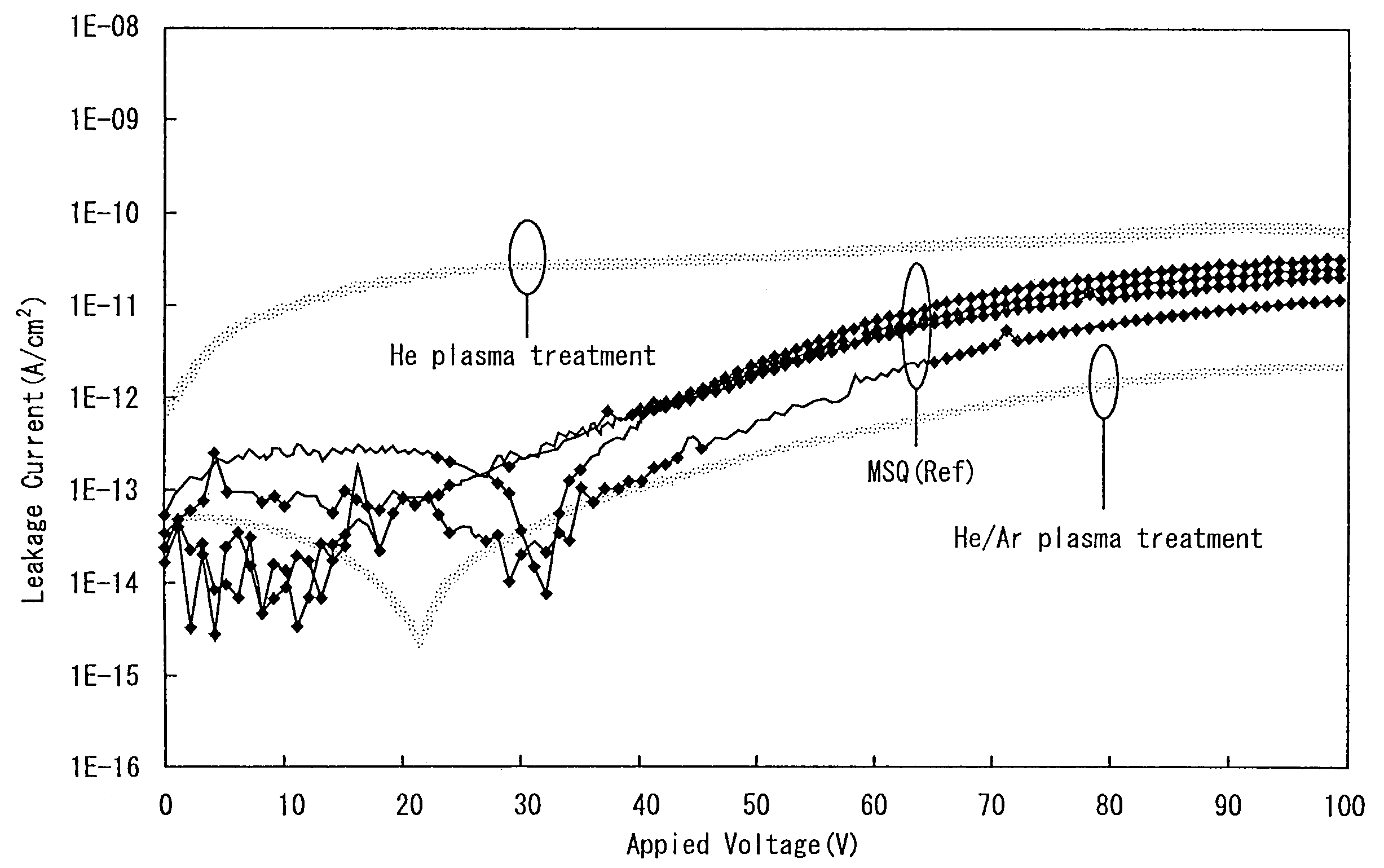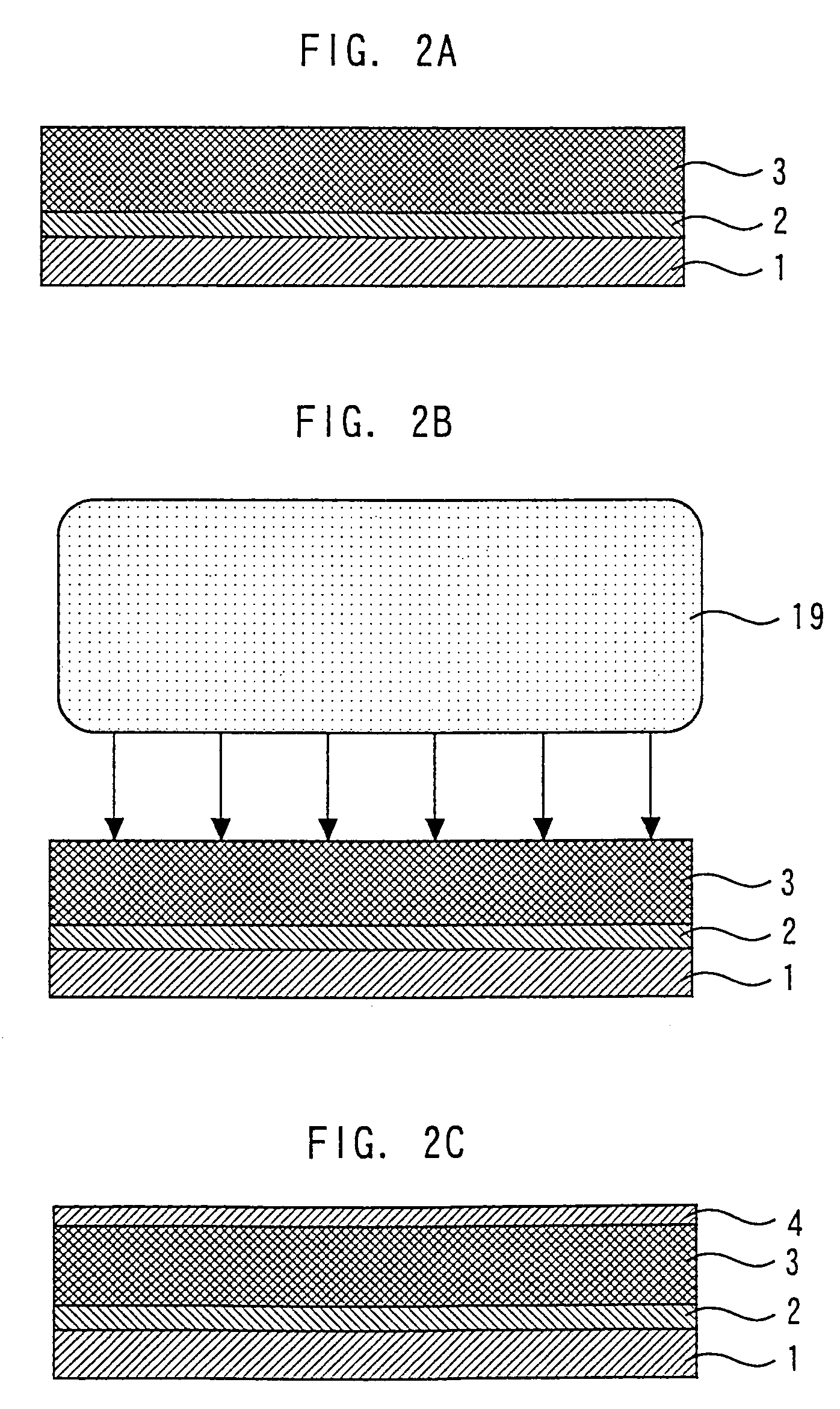Method for manufacturing a semiconductor device that includes plasma treating an insulating film with a mixture of helium and argon gases
a technology of argon gas and insulating film, which is applied in the direction of semiconductor/solid-state device manufacturing, basic electric elements, electric apparatus, etc., can solve the problems of signal delay caused by increase of resistance of metal wirings and capacitance of interlayer insulating films, poor adhesion between different materials, and inability to obtain desired laminated structure. , to achieve the effect of suppressing the increase of leakage current and dielectric constant of the first insulating film, improving
- Summary
- Abstract
- Description
- Claims
- Application Information
AI Technical Summary
Benefits of technology
Problems solved by technology
Method used
Image
Examples
first embodiment
[0018]The present invention relates to a method for manufacturing a semiconductor device that has a multi-layer insulating film as an interlayer insulating film for buried Cu wirings. An example of such a multi-layer insulating film according to the present invention is shown in FIG. 1.
[0019]The multi-layer insulating film shown in FIG. 1 has, in the order from the bottom, an SiO2 film 1; an SiC film 2 of a thickness of 50 nm, which is a stopper for processing a Cu barrier and a trench; an MSQ film 3 of a thickness of 250 nm, which is an interlayer insulating film for vias and trenches; an SiO2 film 4 of a thickness of 50 nm, which is a hard mask for processing; an SiC film 5 of a thickness of 50 nm, which is a stopper for processing a Cu barrier and a trench; a fluorinated allylene film 6 of a thickness of 200 nm, which is an interlayer insulating film for vias; an adhesion promoter 7 of a film thickness of 5 to 15 nm containing a silane coupling agent; an MSQ film 8 of a thickness...
second embodiment
[0037]The method for manufacturing a semiconductor device according to the second embodiment of the present invention will be described below referring to FIG. 4. FIG. 4, however, shows only a part of a multi-layer insulating film shown in FIG. 1, and components such as buried Cu wirings and a substrate are not shown. The components same as the components shown in FIG. 1 will be denoted by the same reference numerals, and the description thereof will be omitted.
[0038]First, as FIG. 4A shows, in the order from the bottom, an SiC film 5 is formed using a plasma CVD method, and a fluorinated allylene film 6, which is a first insulating film, is formed using a spin coating method.
[0039]Next, as FIG. 4B shows, plasma treatment is performed on the surface of the fluorinated allylene film 6 in He / Ar mixed gas containing 5 to 31% Ar.
[0040]After the plasma treatment, as FIG. 4C shows, using the same plasma CVD chamber, an adhesion promoter 7 containing a silane coupling agent is applied onto...
third embodiment
[0042]The method for manufacturing a semiconductor device according to the third embodiment of the present invention will be described below referring to FIG. 5. FIG. 5, however, shows only a part of a multi-layer insulating film shown in FIG. 1, and components such as buried Cu wirings and a substrate are not shown. The components same as the components shown in FIG. 1 will be denoted by the same reference numerals, and the description thereof will be omitted.
[0043]First, as FIG. 5A shows, in the order from the bottom, an SiC film 5 is formed using a plasma CVD method, and a fluorinated allylene film 6, which is a first insulating film, is formed using a spin coating method. An adhesion promoter 7 containing a silane coupling agent is applied onto the fluorinated allylene film 6 using a spin coating method. Here, the film thickness of the adhesion promoter 7 is preferably 5 to 20 nm, and most preferably about 10 nm.
[0044]Next, as FIG. 5B shows, plasma treatment is performed on the ...
PUM
 Login to View More
Login to View More Abstract
Description
Claims
Application Information
 Login to View More
Login to View More - R&D
- Intellectual Property
- Life Sciences
- Materials
- Tech Scout
- Unparalleled Data Quality
- Higher Quality Content
- 60% Fewer Hallucinations
Browse by: Latest US Patents, China's latest patents, Technical Efficacy Thesaurus, Application Domain, Technology Topic, Popular Technical Reports.
© 2025 PatSnap. All rights reserved.Legal|Privacy policy|Modern Slavery Act Transparency Statement|Sitemap|About US| Contact US: help@patsnap.com



